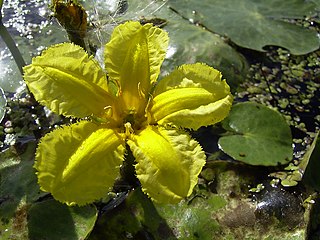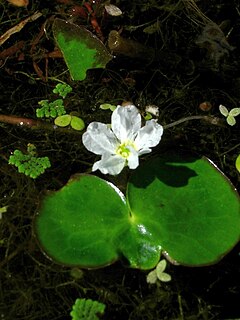
Asterales is an order of dicotyledonous flowering plants that includes the large family Asteraceae known for composite flowers made of florets, and ten families related to the Asteraceae. While asterids in general are characterized by fused petals, composite flowers consisting of many florets create the false appearance of separate petals.

The Solanales are an order of flowering plants, included in the asterid group of dicotyledons. Some older sources used the name Polemoniales for this order.

Menyanthaceae is a family of aquatic and wetland plants in the order Asterales. There are approximately 60-70 species in six genera distributed worldwide. The simple or compound leaves arise alternately from a creeping rhizome. In the submersed aquatic genus Nymphoides, leaves are floating and support a lax, umbellate or racemose inflorescence. In other genera the inflorescence is erect and consists of one to many flowers. The sympetalous, insect-pollinated flowers are five-parted and either yellow or white. The petals are ciliate or adorned with lateral wings. Fruit type is a capsule.

Nymphoides, or floatingheart, is a genus of aquatic flowering plants in the family Menyanthaceae. The genus name refers to their resemblance to the water lily Nymphaea. Nymphoides are aquatic plants with submerged roots and floating leaves that hold the small flowers above the water surface. Flowers are sympetalous, most often divided into five lobes (petals). The petals are either yellow or white, and may be adorned with lateral wings or covered in small hairs. The inflorescence consists of either an umbellate cluster of flowers or a lax raceme, with internodes occurring between generally paired flowers.

Brasenia is a genus belonging to the family Cabombaceae, consisting of one species, Brasenia schreberi. It is widely distributed in North America, the West Indies, northern South America, eastern Asia, Australia, the Indian Subcontinent, and parts of Africa.

Goodeniaceae is a family of flowering plants in the order Asterales. It contains about 404 species in twelve genera. The family is distributed mostly in Australia, except for the genus Scaevola, which is pantropical. Its species are found across most of Australia, being especially common in arid and semi-arid climates.

Iridoids are a type of monoterpenoids in the general form of cyclopentanopyran, found in a wide variety of plants and some animals. They are biosynthetically derived from 8-oxogeranial. Iridoids are typically found in plants as glycosides, most often bound to glucose.

Carpoxylon macrospermum is a species of palm tree endemic to Vanuatu, and the only species in the genus Carpoxylon.

Nymphoides peltata is perennial, rooted aquatic plant with floating leaves of the family Menyanthaceae.

Nymphoides aquatica is an aquatic plant in the Menyanthaceae, native to the southeastern United States from Texas to Maryland. It is known variously as the banana plant, banana lily, and the big floatingheart. It is most commonly called the banana plant because of its banana shaped roots. These unusual roots store nutrients.

Bornesitol is a cyclitol. It can be found in the gentianaceae and menyanthaceae plant families. Chemically, it is a methyl ether of D-myo-inositol.

Nymphoides hydrophylla, commonly known as crested floating-heart, is an aquatic plant of the family Menyanthaceae native to tropical Asia. It has cordate floating leaves that support a lax inflorescence of dainty white flowers with fringed petal margins. Its slim stem (spear) is edible, and is used as vegetable in Taiwan, mostly produced at Meinong District, Kaohsiung.
Nymphoides sivarajanii is a critically endangered aquatic plant of the family Menyanthaceae endemic to Chettipadi in Malappuram district in Kerala, India.

Nymphoides indica is an aquatic plant in the Menyanthaceae, native to tropical areas around the world. It is sometimes cultivated, and has become a minor weed in Florida, where it resembles the native Nymphoides aquatica. Common names include banana plant, robust marshwort, and water snowflake.

Nymphoides balakrishnanii is an aquatic plant in the Menyanthaceae, endemic to lateritic plateaus of the southern Western Ghats of India.
Nymphoides spinulosperma, commonly known as marbled marshwort, is an aquatic plant of the family Menyanthaceae native to eastern Australia. It was described in 1997.
Nymphoides geminata, commonly known as entire marshwort, is an aquatic plant of the family Menyanthaceae native to eastern Australia.

Nymphoides crenata, commonly known as wavy marshwort, is an aquatic perennial herb of the family Menyanthaceae endemic to Australia, found in all mainland states and the Northern Territory

Diphlebia nymphoides is a species of Australian damselfly in the family Lestoideidae, commonly known as an arrowhead rockmaster. It is endemic to eastern Australia, where it inhabits streams and rivers.

Helen Isobel Aston was an Australian botanist and ornithologist.

















